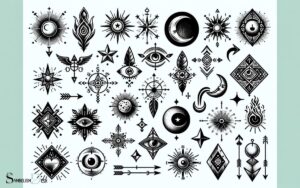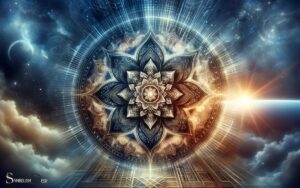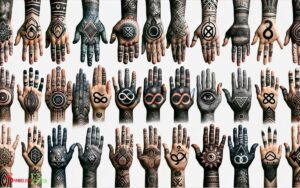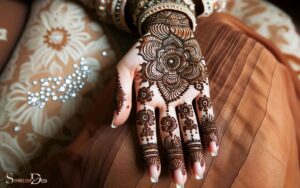Hindu Symbols Tattoos and Meanings: Explain!
Hindu symbols are commonly chosen for tattoos due to their profound spiritual meanings and aesthetic appeal.
The Om symbol represents the sound of the universe, the Lotus Flower is a metaphor for purity and enlightenment, and Ganesha tattoos symbolize wisdom, prosperity, and the removal of obstacles. Hindu symbols are deeply intertwined with the religion’s philosophy and practices.
They often serve as visual representations of complex spiritual concepts:
- Om (ॐ): The fundamental sound of the universe and a powerful spiritual icon in Hinduism, Buddhism, and Jainism. It signifies the essence of ultimate reality, consciousness, or Atman.
- Lotus Flower: This beautiful flower emerges from murky waters, symbolizing purity, spiritual awakening, and the ability to rise above material attachments.
- Ganesha: The elephant-headed deity is one of the most worshiped in the Hindu pantheon, known as the Lord of Beginnings and the Remover of Obstacles, both material and spiritual.
By choosing these symbols for tattoos, individuals often aim to carry the energy and the teachings they represent with them at all times.
Embody the essence of Hindu spirituality through the art of ink with symbols that encapsulate millennia of wisdom and belief.
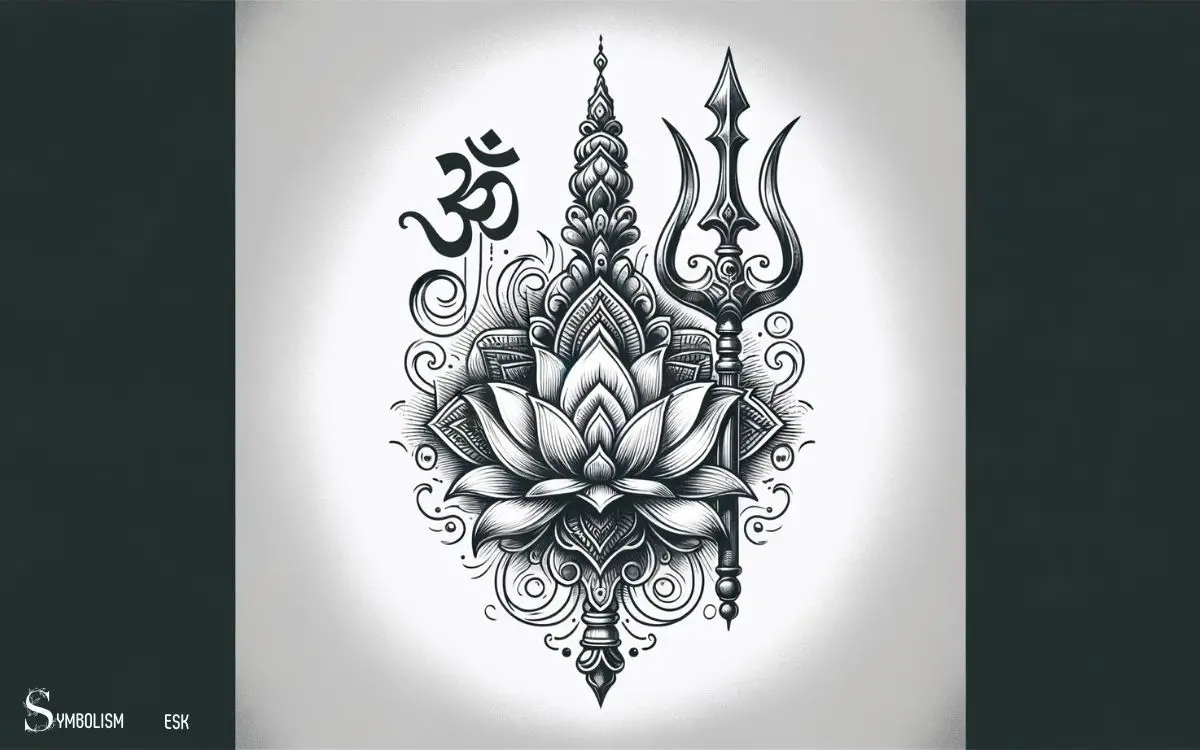
Key Takeaway
The Om Symbol
Exploring the significance of the Om symbol in Hinduism reveals its deep spiritual and cultural importance.
The Om symbol, often chanted during meditation and prayers, represents the sound of the universe and the essence of reality. It’s considered the most sacred sound in Hinduism and is found in ancient scriptures, prayers, and philosophical texts.
The symbol consists of three curves, a dot, and a semicircle, each representing different aspects of the divine.
The sound ‘Om’ is believed to embody the essence of the ultimate reality, representing the three states of consciousness – waking, dreaming, and deep sleep.
It also signifies the triad of Bhrama, Vishnu, and Shiva, the three central deities in Hinduism. Embracing the Om symbol reflects a deep connection to Hindu spirituality and philosophy.
Lotus Flower
The lotus flower holds significant meanings in Hindu culture, serving as a symbol of purity and spiritual enlightenment.
Its presence in Hindu iconography and religious texts underscores its importance as a sacred symbol.
Understanding the deeper symbolism behind the lotus flower can provide insights into its role in Hindu beliefs and practices.
Symbol of Purity
Why is the lotus flower considered a symbol of purity in Hindu culture?
The lotus holds a significant place in Hinduism, symbolizing purity, enlightenment, and beauty. Despite growing in muddy waters, the lotus rises above the impurity, representing spiritual growth and the ability to remain untainted by worldly distractions.
Its unfolding petals are seen as a metaphor for the expansion of the soul and spiritual awakening.
In Hindu mythology, various deities such as Lakshmi, Brahma, and Vishnu are associated with the lotus, further enhancing its symbolism of purity and divine beauty.
The lotus’s ability to emerge from murky waters unsoiled reflects the believer’s journey towards purity and spiritual enlightenment, making it a powerful and revered symbol in Hindu culture.
As a result, the lotus flower is a popular choice for tattoos among those seeking to represent purity and spiritual growth.
Spiritual Enlightenment Symbol
The lotus flower is revered in Hindu culture as a symbol of spiritual enlightenment, embodying purity, divine beauty, and the journey towards spiritual growth.
The unfolding petals of the lotus symbolize the expansion of the soul and spiritual awakening.
In Hindu mythology, deities are often depicted sitting on lotus flowers, signifying their enlightenment and purity.
The lotus also represents the struggles and triumphs of spiritual growth, as it emerges from the mud and blooms into a beautiful flower.
This process mirrors the journey of an individual striving for spiritual enlightenment amidst life’s challenges.
The lotus flower serves as a reminder that even in the darkest and murkiest of times, one can rise above and achieve spiritual purity and enlightenment.
Ganesha
Ganesha, revered as the remover of obstacles, is a popular Hindu deity often depicted with an elephant head. As a symbol of wisdom and intelligence, Ganesha holds significant meaning in Hindu culture.
His imagery evokes powerful symbolism:
- Elephant head with a large, single tusk
- Four arms, each carrying symbolic objects like a noose, goad, and a sweet delicacy
- Pot-bellied figure representing the bounty of nature and the universe
- Mouse as his vehicle, symbolizing the need to control ego and desires
- Lotus flower, symbolizing enlightenment and purity
Ganesha’s presence in Hinduism signifies the overcoming of obstacles and the importance of intellect and wisdom in navigating life’s challenges. These symbols are often incorporated into tattoos as a way to seek Ganesha’s blessings and guidance in overcoming barriers.
Trishula
The Trishula holds great significance in Hinduism, symbolizing divine power and the trinity of creation, protection, and destruction. It’s deeply rooted in Hindu mythology and is often associated with Lord Shiva, one of the principal deities in the religion.
The intricate meanings and representations of the Trishula make it a popular choice for those seeking a tattoo with deep spiritual significance.
Trishula Symbolizes Divine Power
A trishula symbolizes divine power in Hinduism and is a prominent icon in Hindu mythology and religious symbolism. This trident-shaped symbol holds deep significance, representing various aspects of existence and spirituality.
The three prongs of the trishula symbolize the three fundamental aspects of existence: creation, preservation, and destruction. It embodies the concept of the divine trinity of Brahma, Vishnu, and Shiva.
The trident is also associated with the power of Lord Shiva and his ability to transcend the material world.
It signifies the control over the mind, intellect, and ego, leading to spiritual growth and realization. The trishula is often wielded by various deities, signifying their authority and protection over the universe.
This symbolism sets the stage for understanding how the trishula represents creation, protection, and destruction.
Represents Creation, Protection, Destruction
Representing creation, protection, and destruction, the trishula is a powerful symbol in Hinduism. It embodies the fundamental aspects of existence and spirituality.
Frequently associated with the divine trinity of Brahma, Vishnu, and Shiva, the trishula holds deep significance in Hindu mythology and religious symbolism.
The trishula’s three prongs are often interpreted to represent various trinities such as past, present, and future, or the three gunas – sattva, rajas, and tamas.
Additionally, it symbolizes the three aspects of consciousness – waking, dreaming, and dreamless sleep.
As a weapon wielded by Lord Shiva, the trishula signifies his role as the destroyer of evil and ignorance, yet also as the protector and preserver of the universe.
In essence, the trishula encapsulates the cyclical nature of existence, reminding individuals of the constant interplay between creation, preservation, and dissolution.
Significance in Hinduism Mythology
Signifying the trinity of creation, protection, and destruction, the trishula holds deep significance in Hindu mythology and religious symbolism.
In Hinduism, the trishula represents various concepts and holds great importance:
- Lord Shiva: The trishula is often associated with Lord Shiva, symbolizing his power to create, protect, and destroy.
- Three Gunas: It represents the three fundamental qualities of existence – sattva (purity), rajas (passion), and tamas (ignorance).
- Triad of Deities: The trident embodies the divine trinity of Brahma, Vishnu, and Shiva, representing creation, preservation, and destruction.
- Past, Present, Future: It symbolizes the three aspects of time – the past, present, and future.
- Mind, Body, Soul: The trishula also signifies the interconnectedness of the mind, body, and soul in Hindu spiritual beliefs.
Mandala Designs
Mandala designs, often used in Hindu symbol tattoos, are intricate geometric patterns that hold deep spiritual significance in Hindu culture. These circular designs symbolize the universe, representing the cosmic and psychic order.
Mandalas are used in Hinduism to aid in meditation, as gazing at the intricate patterns can help focus the mind and lead to spiritual awakening.
Each element within the mandala holds symbolic meaning, such as the lotus flower representing purity and enlightenment, and the concentric circles representing the journey towards the center of the self.
The use of mandala designs in Hindu symbol tattoos reflects a deep connection to spirituality and a desire for inner peace and harmony.
Moving forward, it’s important to understand the significance of another Hindu symbol, the swastika.
Swastika Symbol
The swastika symbol, an ancient Hindu emblem, holds significant cultural and spiritual importance in Hinduism, and its use in tattoos reflects a deep connection to spirituality and a desire for inner peace and harmony.
- The swastika, often depicted as an equilateral cross with its arms bent at right angles, symbolizes good fortune and well-being.
- In Hinduism, it represents the sun, prosperity, and the cycle of creation and destruction.
- The swastika is also associated with the god Ganesha, the remover of obstacles, and is believed to bring good luck and ward off evil.
When used in tattoos, the swastika serves as a powerful reminder of the interconnectedness of all things and the eternal quest for spiritual growth.
Its intricate patterns and meaningful symbolism make it a popular choice for those seeking to embody the timeless wisdom of Hindu traditions.
Nataraja Symbol
Nataraja, a Hindu symbol often associated with dance and cosmic energy, reflects another facet of spiritual significance in Hindu tattoos.
Nataraja, the Lord of Dance, is a representation of the Hindu god Shiva in his form as the cosmic dancer. The Nataraja symbolizes the dynamic forces of the universe and the continuous cycle of creation and destruction.
In Hindu tattoos, the Nataraja symbol is often depicted with multiple arms and a circle of fire, representing the cosmic energy of the universe. The dance of Nataraja is seen as a symbol of the rhythmic movement of the universe and the balance of life.
People who choose to incorporate the Nataraja symbol in their tattoos often seek to embody the idea of embracing change and finding harmony within the ever-changing nature of existence.
Conclusion
Hindu symbols tattoos and their meanings are a powerful way to express spirituality and culture. From the peaceful Om symbol to the majestic Nataraja symbol, each design holds deep significance and beauty. Understanding tribal tattoo meanings is essential for appreciating the rich history and tradition behind these powerful symbols. Each line and curve holds a story, making tribal tattoos a unique and personal form of expression for the wearer. Whether it’s a geometric pattern or an animal motif, tribal tattoos showcase the diversity and creativity of ancient cultures.
Embracing these timeless symbols through tattoos can bring a sense of connection and clarity. So, whether it’s the lotus flower or the trishula, Hindu symbols tattoos are a meaningful and magnificent way to honor ancient traditions and beliefs.


